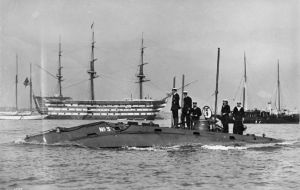MercoPress. South Atlantic News Agency
The Rebellious reason British submarines fly the Jolly Roger after missions
 The First Sea Lord also posted an image of HMS Utmost flying a Jolly Roger in 1942, showing how the tradition has been carried on through the Second World
The First Sea Lord also posted an image of HMS Utmost flying a Jolly Roger in 1942, showing how the tradition has been carried on through the Second World  When the Royal Navy launched its first submarine in 1901, the Sea Lord said submarines were ‘underhand, unfair, and damned un-English’
When the Royal Navy launched its first submarine in 1901, the Sea Lord said submarines were ‘underhand, unfair, and damned un-English’ The sight of a Jolly Roger flag once struck fear into the hearts of sailors at sea as it often meant a bloodthirsty band of pirates were about to launch a deadly attack – but there is a fascinating, if not somewhat rebellious, reason why today’s Royal Navy submarines fly the iconic skull and crossbones as part of a tradition that dates back to the First World War.
Britain’s Submarine fleet might now be seen as an unrivalled Silent Service that gives the Royal Navy strength beneath the waves but that was not always the case.
In its early days, the service was not so well regarded in all quarters of the navy, with some suggesting that underwater warfare was, well, just not cricket.
When the Royal Navy launched its first submarine in 1901, the then First Sea Lord, Admiral Arthur Wilson, reportedly stated that submariners were ‘nothing more than tradesmen’.
He added that submarines were ‘underhand, unfair, and damned un-English,’ with some suggestions that submarine crews should be hanged as pirates.
The service had only been in operation for just over a decade when the First World War broke out in 1914 and had yet to prove itself in battle.
Submariner Lieutenant-Commander, later to become Admiral, Sir Max Horton, had at the time been in command of one of the first of Britain’s ocean-going submarines, HMS E9, which notched up a series of successful operations as the war developed – including torpedoing the German SMS Hela off the coast of the North Sea archipelago Heligoland, and the sinking of the German destroyer S116, for which he was awarded the Distinguished Service Order.
Britain’s Submarine Service began earning a reputation as an effective fighting force that was making a significant strategic difference to the course of the war.
Another British submarine attack on the Prinz Adalbert in October 1915 inflicted what was perhaps one of the greatest single losses for the German Navy in the Baltic – helping to seal the reputation of Britain’s submarines as a vital part of the Royal Navy’s fleet.
Following a series of victorious operations, the then Lieutenant Commander Max Horton, remembering the comments about submarine crews being thought of as ‘pirates’ offered a retort to the initial sentiment – by flying a Jolly Roger from his submarine on return from a successful patrol.
He carried on this practice – adding another flag on the submarine each time he returned from a successful operation.
However, the submarines started to win victory after victory, so the collection of flags flown from the top of the conning tower soon became numerous, so that practice was swapped – with a submarine flying one single large Jolly Roger flag, with symbols indicating each of the submarine’s successes sewn on to the flag.
The current First Sea Lord, Admiral Sir Tony Radakin, paid homage to the legacy of Admiral Sir Max Horton in a post on Twitter earlier this month, marking “70 years since the passing of Admiral Sir Max Horton” and adding: “As Captain of HM Submarine E9 he instigated the tradition of submarines flying the Jolly Roger on successful return from patrol.”
Symbols included bars, to shows how many hits on ships had been notched up, with each bar representing ships torpedoed. However, post-war flags sometimes depict the silhouette of a ship instead. Symbols of mines indicated mine-laying operations, while other operations, such as when a submarine was used as a navigation marker, were depicted by torches or lighthouses.
Commanders of submarine flotillas followed in the footsteps of Sir Max and even began issuing Jolly Roger flags to submariners, with procedures issued for how they should be used and displayed.
Reports suggest not all submarines joined in the practice, with some fearing that flying the flag was too boastful, or that successes could not always easily be confirmed. However, some Allied submariners and Commonwealth nations did follow suit during the Second World War – flying the Jolly Roger on return from missions.
The practice later turned into tradition – with other submarine commanders paying homage to the original practice by Admiral Sir Max Horton and this has continued throughout the 20th Century and into the 21st.
There is no official Royal Navy policy in place to govern the flying of Jolly Roger flags, but submarine commanders have been known to follow the tradition, with some submarines spotted flying the flag on their return to port at Faslane. (Forces/Net)




Top Comments
Disclaimer & comment rulesCommenting for this story is now closed.
If you have a Facebook account, become a fan and comment on our Facebook Page!